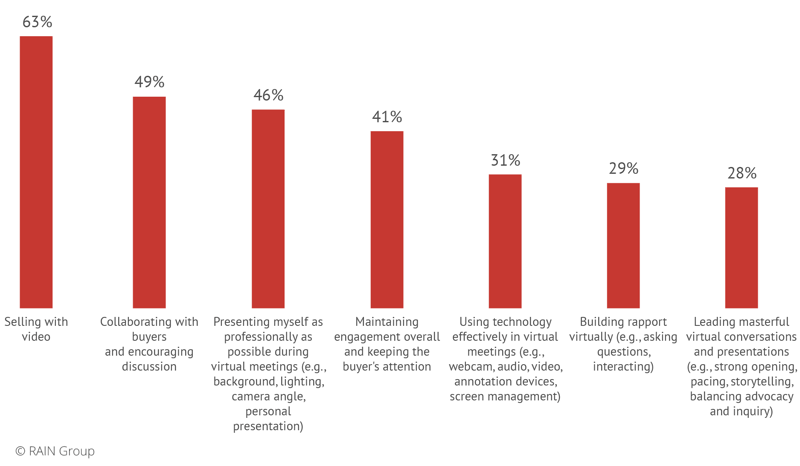Have you met Morgan? A terrific sales rep. Except recently, Morgan has slipped out of the top tier of the leaderboard and I think I know why: she struggles to adapt to the new selling environment.
Given the current landscape in B2B sales, you may have a few Morgans on your team. Even the most experienced sellers are finding they need to excel at selling across multiple modes: in-person, remote, and hybrid. In fact, B2B buyers often use more than nine channels in their buying process, including email, in-person, phone, video conference, chat, etc., according to research from McKinsey.
This requires a new approach from sellers to excel across these areas.
The Difference Between In-Person, Remote, and Hybrid Sales
In-Person Selling
Back in the day, most of Morgan’s selling activities took place on calls or during in-person meetings and events. Most sales professionals are well accustomed to in-person selling, which has its advantages and disadvantages.
On the one hand, in-person selling is terrific for building rapport. For more complex products and sales cycles, in-person selling is often a requirement. Yet in-person selling can also cost more time and money than other modes of selling and sometimes it’s just not possible.
Remote Selling
Some teams now conduct their entire sales cycle remotely, including demand generation and pre-sales activities, needs discovery, demos, solution presentations, and negotiations.
The advantages of a 100% remote selling process include expanded reach, cost and time efficiency, more standardized processes, and greater flexibility. However, it can also come with some disadvantages, including a lack of personal touch, technical issues, and buyer experience challenges.
Hybrid Selling
Hybrid selling, a combination of in-person and remote selling, has become increasingly popular as businesses seek to balance the benefits of both approaches. Teams can tailor the hybrid selling process to meet the needs of specific buyer personas and buying teams, industries, and even product lines. This mode allows for tremendous flexibility for sellers as well as buyers.
But, like remote selling, hybrid selling relies heavily on technology, which can sometimes fail or create issues that impact the buyer experience. And, frequently, it requires additional training and management, as sellers need to be comfortable with in-person and remote sales modes.
Hybrid Selling Is the Future of B2B
It’s more important than ever to ensure the sales force you do have is capable of selling the way today’s buyers are buying.
Hybrid selling is the future of B2B sales, according to McKinsey & Company. Their research found that 60% of companies increased their hybrid sales teams in 2021, a trend that continues.
Indeed, RAIN Group’s recent research on the skills and behaviors of Top-Performing Sales Managers and Sellers found that 43% of selling is happening in a primarily hybrid mode, 32% of selling is happening in a mostly remote mode, and only 25% of selling is happening mostly in person.
Given the distribution here, it’s not surprising that the best sellers have figured out how to navigate each selling environment. Top Performers excel at both in-person and remote selling and appear to easily shift between selling modes.
They are not only skilled at selling across the sales cycle (prospecting, needs discovery, solution crafting, solution presentation, and negotiating), but also excel at the specific skills needed when selling remotely.
Top Performers Are More Likely to Excel at Specific Skills in a Remote Environment
% More Likely Than The Rest to Excel

Adapt Selling Skills to Fit the Environment
It’s possible for sellers like Morgan to improve their skills so they can successfully shift between in-person and remote selling modes like Top Performers do.
1. Building Relationships
It can be harder to build rapport and relationships when selling remotely than when meeting with buyers in person. In fact, 88% of sellers struggle with developing relationships with buyers virtually.
It takes a more deliberate approach to develop strong, trusting relationships, an approach that Top Performers are 1.3x more likely to excel at when it comes to building rapport virtually.
Here are a few things you can do to help build rapport virtually:
- Turn your video on: You make deeper connections with buyers when they can see you.
- Make time for rapport: Too often in virtual meetings sellers jump straight to the agenda. Leave time at the beginning of your call to ask questions about their weekend or where they are in the world, or to offer a compliment (only if its genuine) about their background or something you saw on their LinkedIn profile.
- Monitor engagement: When your video is on, buyers are more likely to follow suit and turn theirs on as well. This allows you to more easily monitor engagement and drive engagement during your virtual meetings if you notice participants are zoning out. The more engaged buyers are, the stronger the connection you’ll build with them.
2. Driving and Discovering Need
Sellers need to connect with buyers and master the needs discovery process. Buyers tell us that when they’re interacting with a seller virtually, the seller’s needs discovery has the greatest influence on their purchase decision. Yet, according to buyers, only 26% of sellers are skilled at this.
When it comes to needs discovery, the best sellers excel here regardless of mode.
For example, Top-Performing Sellers are 58% more likely than other sellers to lead thorough needs discoveries. And, in a remote environment, Top Performers consistently outperform others when it comes to:
- Collaborating with buyers and encouraging discussion (1.5x more likely to excel)
- Selling with video (1.6x more likely)
However, across the board, most sellers struggle when it comes to these aspects of virtual selling. Eighty-two percent say they’re very or somewhat challenged by collaborating and interacting with buyers virtually.
Sellers may (or may not) be confident doing this in a face-to-face setting. Shift to a remote setting and even the most seasoned sellers can be put off balance by the added layers of tech tools (and tech issues), keeping buyers engaged, and uncovering the full set of needs. Here are a few tips:
- Leverage email: As noted above, buyers are engaging on more channels than ever. Prior to your meeting, ask a few needs discovery questions via email. Get as much information ahead of time as you can to make the most of your time together—whether it be in person or virtual.
- Master the tech: Take the opportunity before sales conversations to practice and use the tools and techniques that will help you make the needs discovery process a success. Learn to collaborate in virtual meetings.
- Drive buyer need: Sometimes buyers don’t know what they need or don’t know what’s available to them. You can drive demand, shape buyer needs, and inspire buyers by telling a convincing story.
- Ask insightful questions: Much of your needs discovery success is determined by the questions you ask. Whether in person or remote, asking the right questions at the right time will help you uncover buyer needs and desires. Here are 10 such questions you can use in your conversations.
3. Filling the Pipeline
While prospecting might not be a new imperative for sellers, the means of filling the pipeline have evolved. Sellers not only need to be comfortable meeting face-to-face with potential buyers at events and in-person meetings, but also reaching out and connecting with people by phone, email, video, and social media such as LinkedIn.
Tip: Keep your LinkedIn profile updated and active. Our Top Performance in Sales Prospecting report shows that 82% of buyers look up providers on LinkedIn before replying to outreach. If your prospect goes to your LinkedIn page, will they like what they find?
Learn more: How to Fill Your Sales Pipeline
4. Avoid Virtual Selling Mistakes
Sellers aren’t the only professionals moving to hybrid working environments. Most B2B buyers now spend a fair amount of time in remote settings, and most can spot their turn-offs from a mile away. These include:
- Problems with the tech
- A lack of adequate visuals
- No attention paid to questions or concerns
- Lack of preparedness
- Poor or unpolished presentation skills
- Sloppy emails
- Distracted reps
- Unprofessional appearance and demeanor
Even well-meaning, well-prepared sellers make some or all of these mistakes, sometimes without even knowing it.
To learn how to avoid these mistakes, download our virtual selling checklist.
5. Build a Diversified Toolbox
A seller’s digital tools ought to support and enhance their efforts—on the phone, over email, or otherwise.
Could you be getting more out of Zoom meetings by making better use of the digital whiteboard, for example?
Have you incorporated video into your hybrid selling?
How are you using email? Chat? Leveraging your website? And so on.
The best sellers realize the value of a diversified set of sales tools and skills. Top Performers are 1.6x more likely than The Rest to excel at selling with video and 1.5x more likely to collaborate with buyers and encourage discussion.
As for a real-world example, I’ve met multiple sellers who use a video capture tool such as Vidyard to send short videos in place of emails or text.
One important step to building a diversified toolbox is to learn your company’s presentation tools inside and out, including any features that support collaboration.
7. Learn to Capture Attention
We love Morgan, but for the purposes of this blog post, Morgan’s my attention-grabber—hopefully making it real and relatable right from the start.
That’s something sellers can learn from. In fact, 91% of sellers say that gaining a buyer’s attention is a top challenge of virtual selling. And it holds for all modes of selling, albeit on a different scale.
One strategy for capturing attention is the 30+3 rule: aim to grab attention within the first thirty seconds and then work to regain it every three minutes. The best sellers can do this in person, as well as virtually.
For example, structured interactions can be done regardless of the selling mode. Whiteboarding can happen in front of an actual whiteboard during an in-person meeting or on a virtual whiteboard built into your presentation software.
Make attention a requirement. One way to do this is by calling on people by name and asking for interaction. For example, you can say, “Mary, I’m curious to know your reaction to that.” This puts everyone in the meeting on notice to pay attention. They may be called on next! This works whether you’re in the same room or a video meeting attending from opposite sides of the world.
How to Cultivate a Sales Team that Thrives in Hybrid Sales
Organizations can help their sales teams adapt to a hybrid sales environment by ensuring two things:
- Sellers are skilled at selling across the sales cycle and share the competencies demonstrated by Top-Performing Sellers.
- Like Top Performers, they excel at the specific skills needed when selling remotely and can shift between selling modes as needed.
The good news for sales organizations—and Morgan—is that these are all skills that can be learned.






